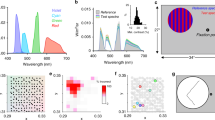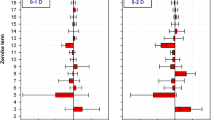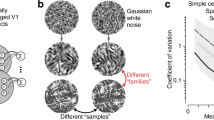Abstract
PERCEPTION of any visual pattern is subject to three well-known forms of adaptation. In the first place a ‘negative after-image’ is formed which tends to reduce the contrast between the brightnesses of neighbouring areas. Secondly, after more prolonged fixation, peripheral parts of the visual field tend to fade from view in large patches. With a stabilized retinal image, it is well known that a third type of adaptation can occur, in which the whole field fades and reappears intermittently.
This is a preview of subscription content, access via your institution
Access options
Subscribe to this journal
Receive 51 print issues and online access
$199.00 per year
only $3.90 per issue
Buy this article
- Purchase on Springer Link
- Instant access to full article PDF
Prices may be subject to local taxes which are calculated during checkout
Similar content being viewed by others
References
MacKay, D. M., Nature, 180, 849 (1957).
Lettvin, J. Y., Maturana, H. R., McCulloch, W. S., and Pitts, W. H., Proc. Inst. Radio Eng., N.Y., 47, 1940 (1959).
Hubel, D. H., and Wiesel, T. N., J. Physiol., 148, 574 (1959).
Arden, G. B., J. Physiol., 166, 468 (1963).
MacKay, D. M., in Sensory Communication, edit. by Rosenblith, W. A., 339 (M.I.T. and Wiley, 1961).
MacKay, D. M., Nature, 180, 1145 (1957).
Author information
Authors and Affiliations
Rights and permissions
About this article
Cite this article
MACKAY, D. Central Adaptation in Mechanisms of Form Vision. Nature 203, 993–994 (1964). https://doi.org/10.1038/203993b0
Published:
Issue Date:
DOI: https://doi.org/10.1038/203993b0
Comments
By submitting a comment you agree to abide by our Terms and Community Guidelines. If you find something abusive or that does not comply with our terms or guidelines please flag it as inappropriate.



